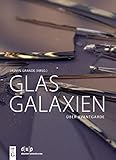Glasgalaxien : Über Avantgarde / hrsg. von Jasmin Grande.
Material type: TextPublisher: Berlin ; Boston : De Gruyter, [2022]Copyright date: ©2022Description: 1 online resource (205 p.)Content type:
TextPublisher: Berlin ; Boston : De Gruyter, [2022]Copyright date: ©2022Description: 1 online resource (205 p.)Content type: - 9783110753202
- 9783110753455
- online - DeGruyter
- Issued also in print.
| Item type | Current library | Call number | URL | Status | Notes | Barcode | |
|---|---|---|---|---|---|---|---|
 eBook
eBook
|
Biblioteca "Angelicum" Pont. Univ. S.Tommaso d'Aquino Nuvola online | online - DeGruyter (Browse shelf(Opens below)) | Online access | Not for loan (Accesso limitato) | Accesso per gli utenti autorizzati / Access for authorized users | (dgr)9783110753455 |
Frontmatter -- Inhaltsverzeichnis -- Einleitung -- Glasarchitektur als Denkraum von der Moderne bis zur Gegenwart -- Gläser aus physikalischer Sicht -- Scherbenbilder I, 2021/22 -- Buntglas – Prisma – Spiegel -- Glas – Kunst? -- Paul Klee – Hinterglasmalerei -- Glasgalaxien, 2021/22 Weitere Farbtafeln -- Transparenz im Treibhaus -- Glasgedichte – Kontinuitäten eines Motivs vor und nach 1945 -- Von Fenstern, Spiegeln und globalen Utopien -- Scherbenbilder II, 2021/22 -- Glas – fantastisches Material der polnischen Unabhängigkeit -- Kurzbiographien -- Bildnachweise
restricted access online access with authorization star
http://purl.org/coar/access_right/c_16ec
Anfang des 20. Jahrhunderts entdeckte die Avantgarde Glas als Material und untersuchte dessen utopisches Potenzial. Berühmt sind Glaskunstwerke wie Bruno Tauts Beitrag zur Werkbundmesse 1914 oder die Gründung der "Gläsernen Kette" 1919. Transparent, fluide, sakral und diaphan – den Weg in die Glasavantgarde hatte die Literatur geebnet, konkret wurde das Denkbild an Orten der Glasproduktion, z.B. in Düsseldorf. Glas fungiert bis heute als Transmitter für künstlerische Gestaltung, als abstrahierendes Element, als Motor im Projekt des Universalunterrichts zwischen Kunst und Gesellschaft. Der Band untersucht Glas als Material und als Denkbild in interdisziplinärer Perspektive von der Kulturgeschichte des 20. Jahrhunderts bis zur Physik der weichen Materie.
At the beginning of the twentieth century, the avant-garde discovered glass as a material and examined its utopian potential. Glass artworks like Bruno Taut’s contribution to the Werkbund Fair of 1914 or the founding of the “Crystal Chain” in 1919 are well known. Transparent, fluid, sacred, and diaphanous—literature smoothed the way to the glass avant-garde, and the conceptualizations became concrete in places where glass was produced, for instance in Dusseldorf. Glass serves until today as a transmitter of artistic design, as an abstracting element, an engine in the project of universal lessons between art and society. The volume examines glass as a material and image of thought in an interdisciplinary perspective from the cultural history of the twentieth century to soft matter physics.
Issued also in print.
Mode of access: Internet via World Wide Web.
In German.
Description based on online resource; title from PDF title page (publisher's Web site, viewed 29. Mai 2023)


